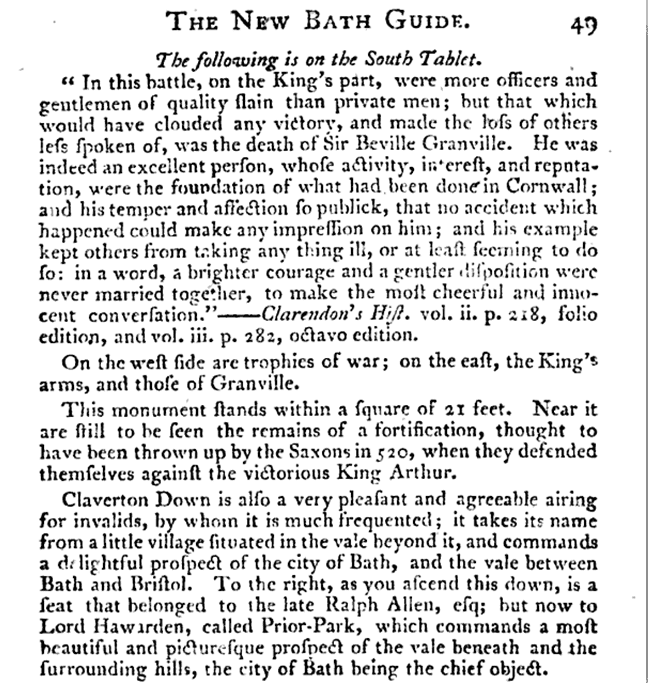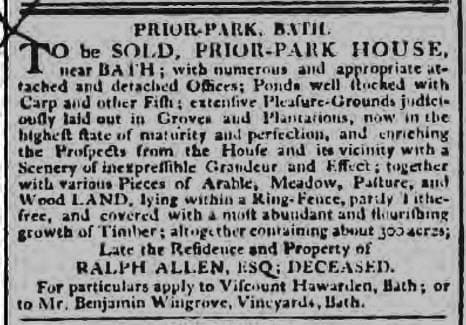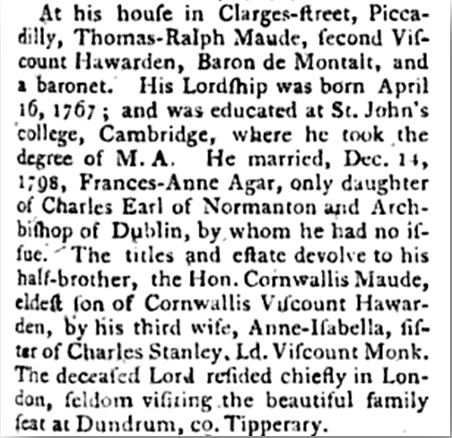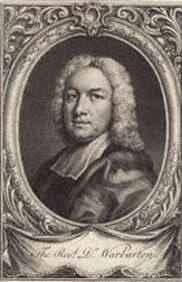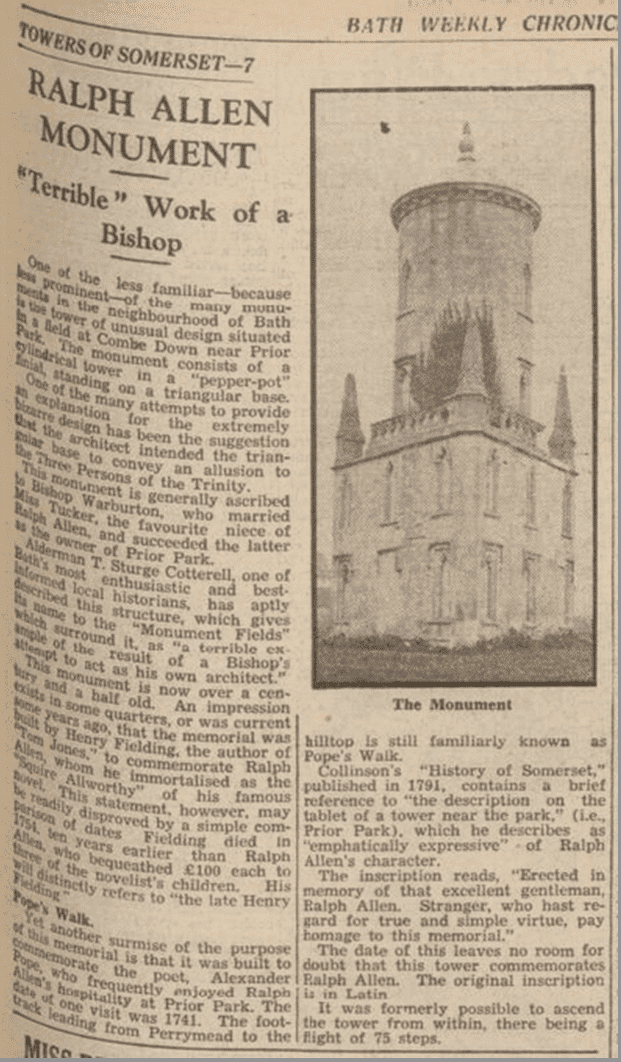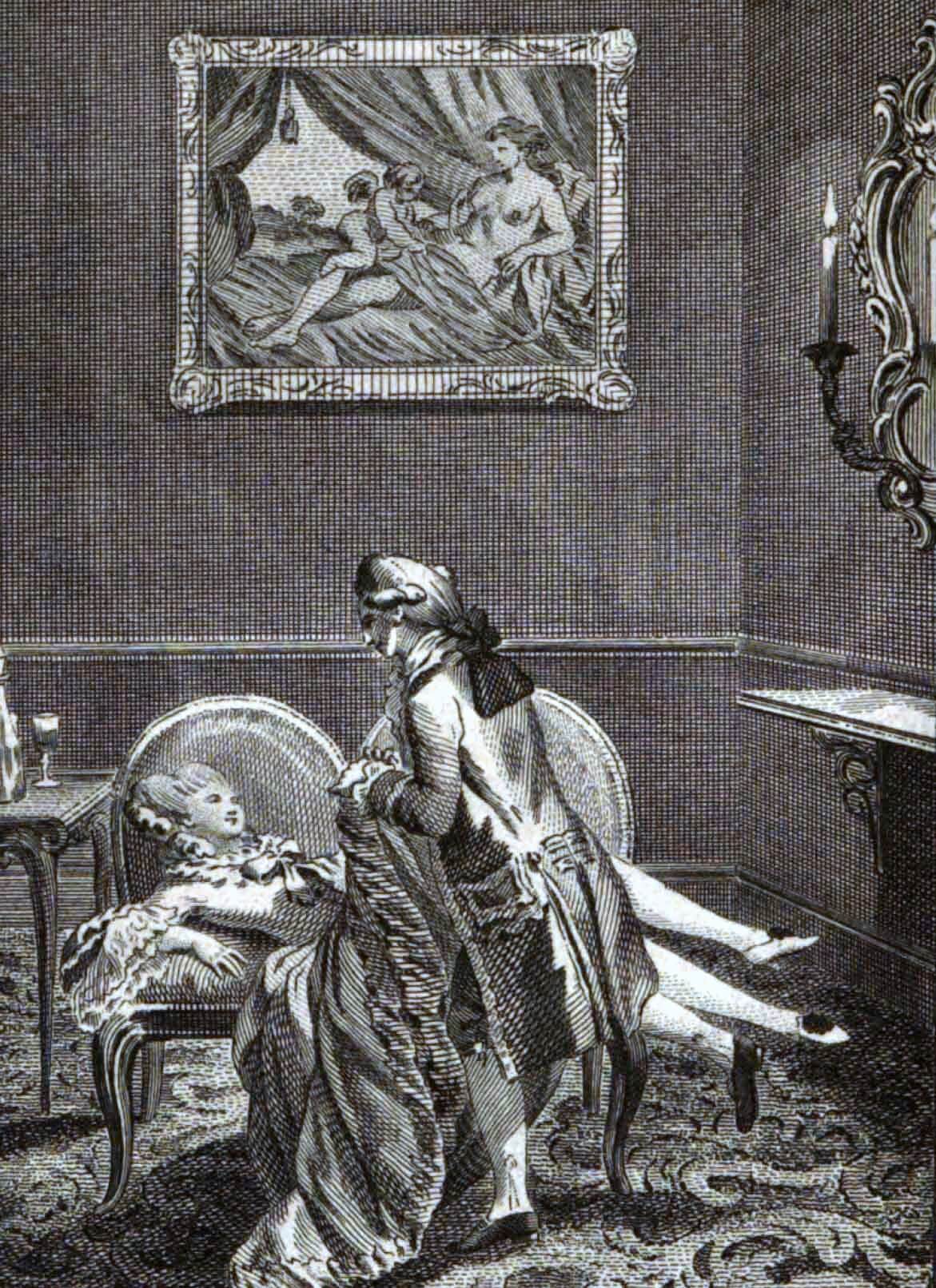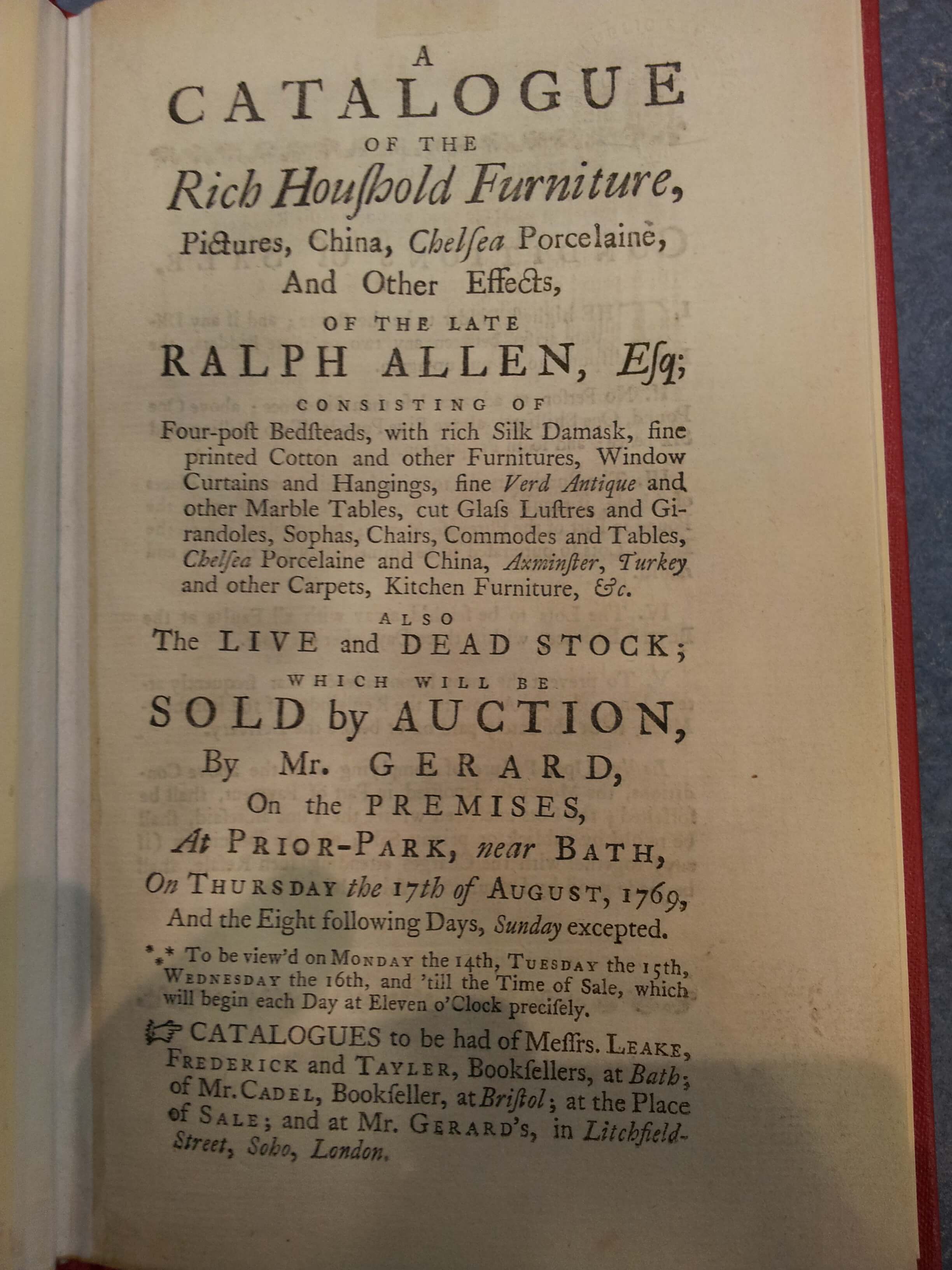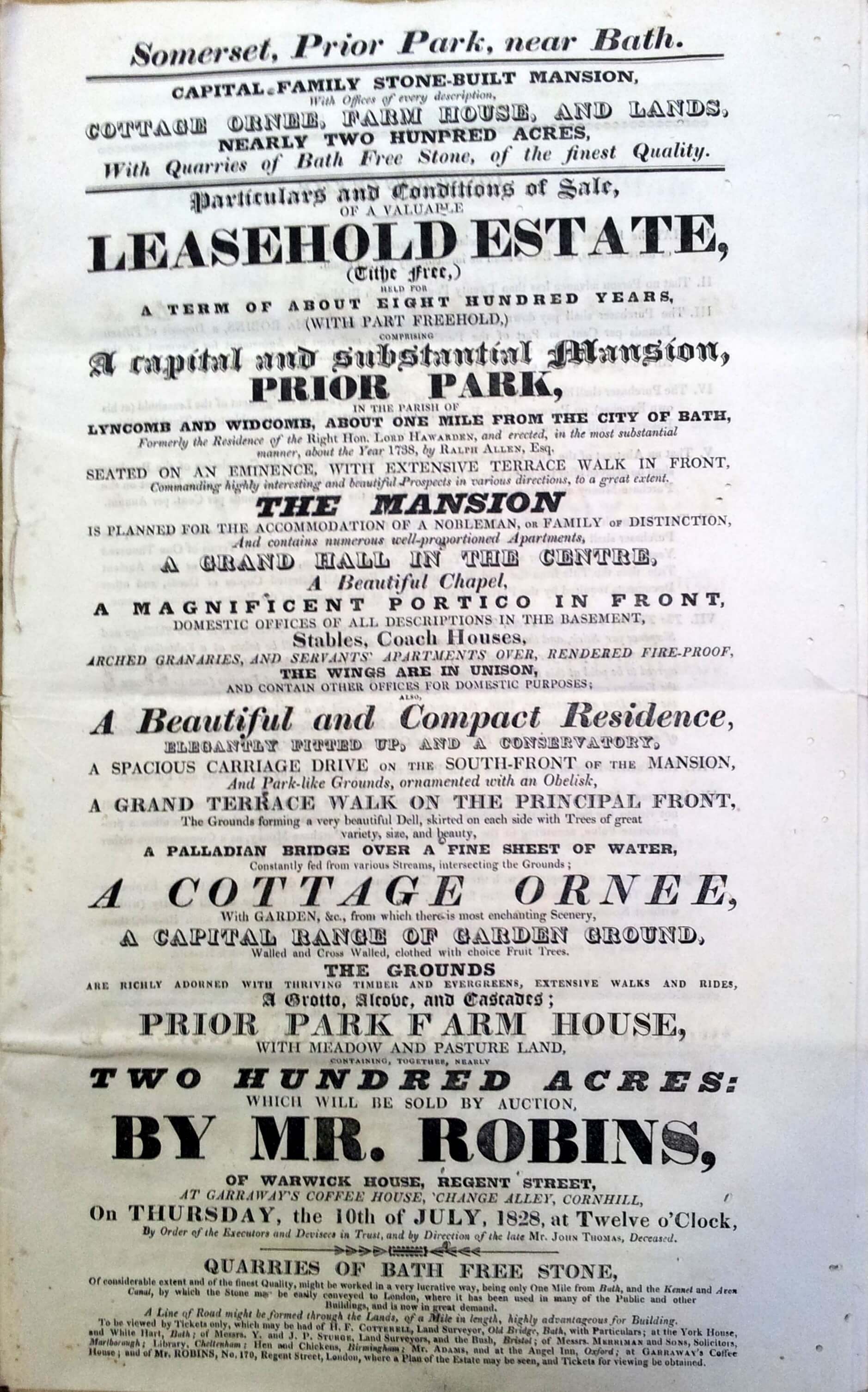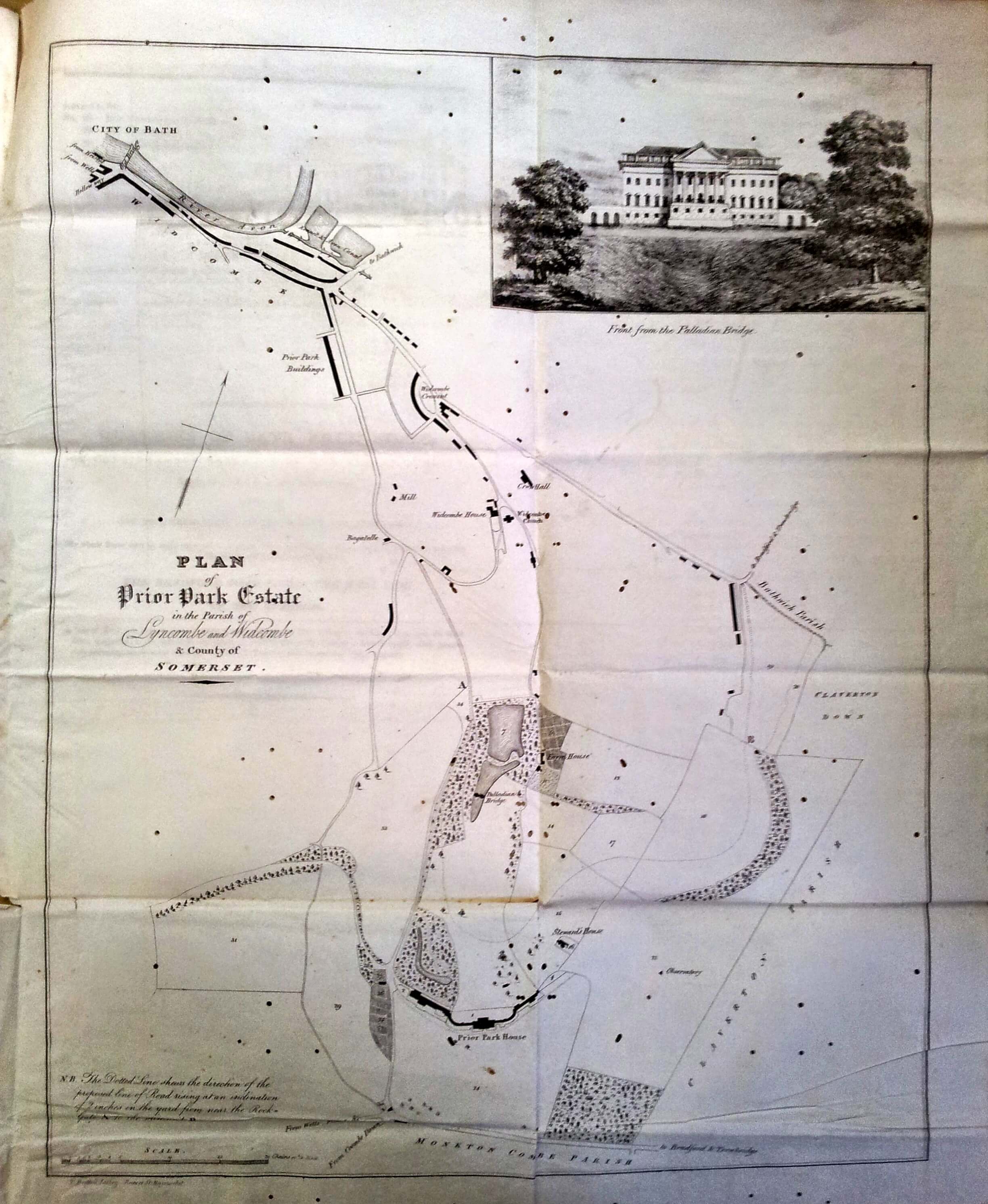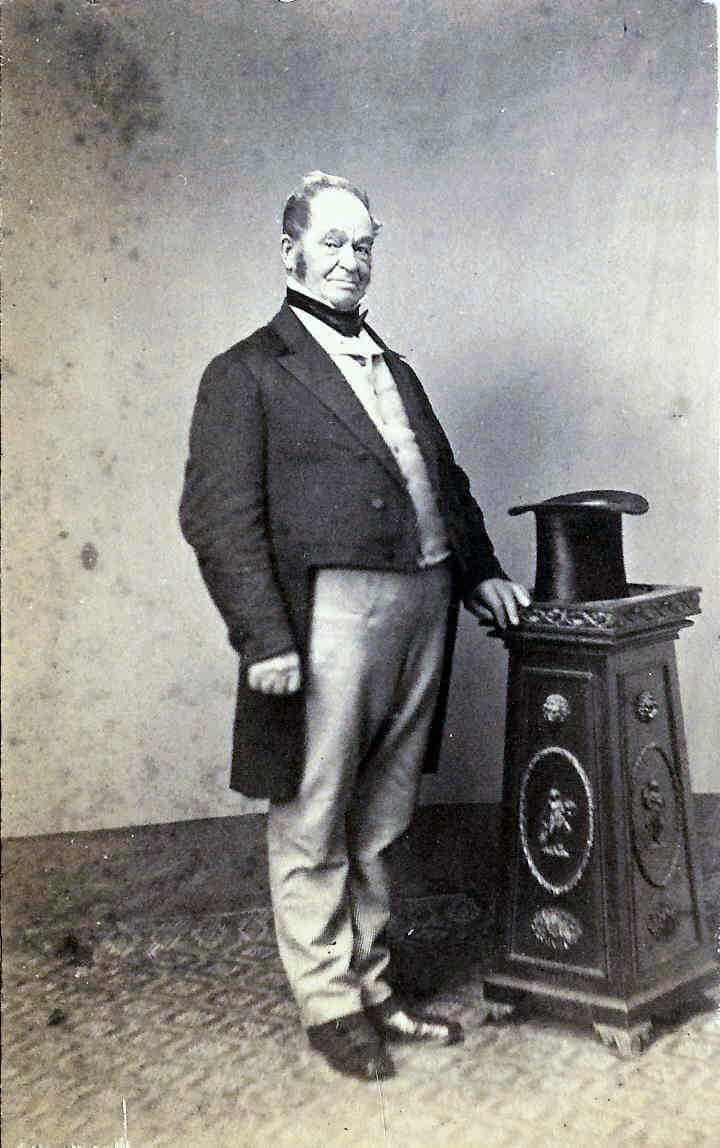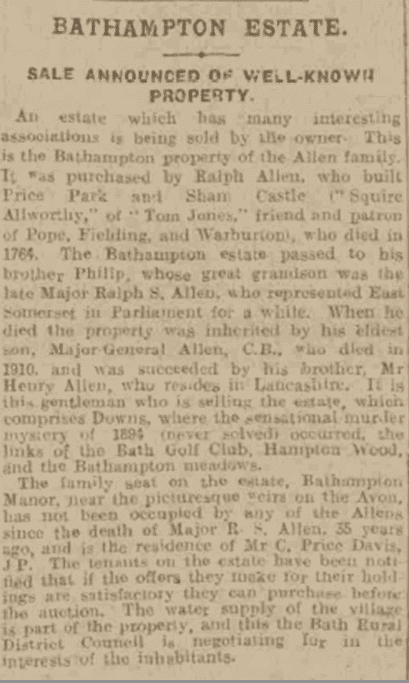Prior Park after Ralph Allen
Ralph Allen (1693 – 1764) left his estate to his wife Elizabeth Holder but she died in 1766.
By his will the estate then passed to his niece Gertrude Tucker (abt 1727 – 1796 ), who lived there for some years. However, after Ralph Allen’s death his postal contracts had been called in and thus the family income substantially diminished. Looking after Prior Park must have been a time consuming and costly undertaking and, as Ralph Allen had also left substantial cash bequests of well over £50,000 in his will, cash flow must have been very tight.
Gertrude Tucker (abt 1727 – 1796 ) decided to move out and let the estate, possibly for as much as £4,000 p.a. Having removed some items there was a sale of the remaining contents of Prior Park[1] in 1769. The sale went on over 9 days (10 elapsed) from August 17th to August 26th. It covered everything from an: “iron fender, tongs, poker, shovel and coal tub” to “two pair of china figures”, “six needle-work calico curtains”, “a mahogany writing table” to “an Alderney cow”.
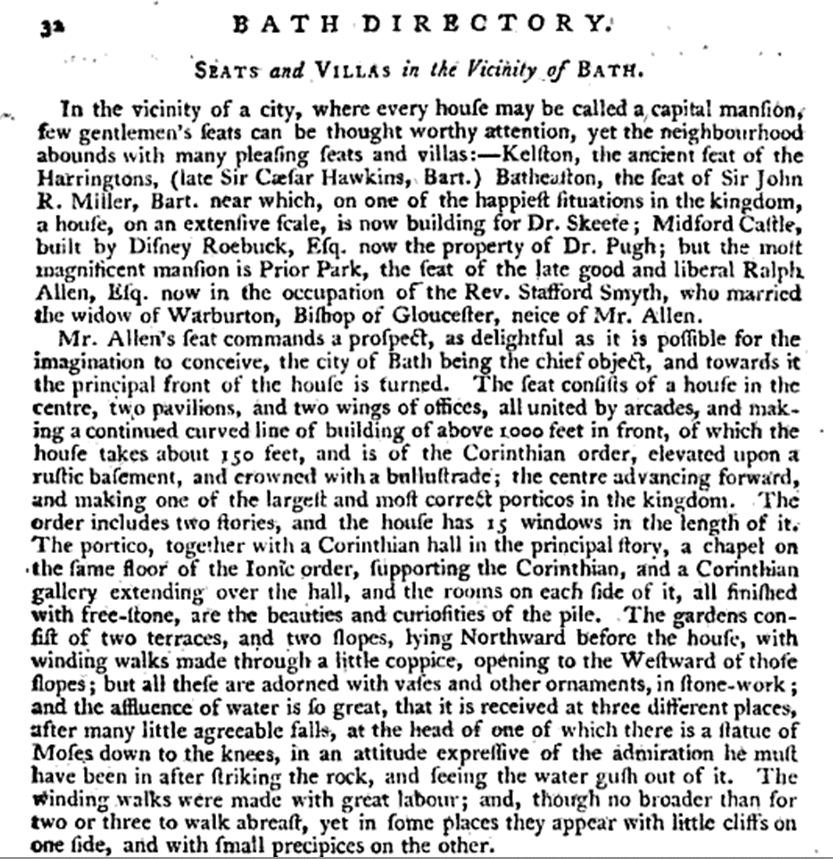
Prior Park was then let, apparently to Lord Kerry as the extract from Thomas Parson diary tells us and it is confirmed by a letter from William Warburton, dated September 4th, to Richard Hurd, Bishop of Lichfield and Coventry and Worcester[3].
Rt Rev Dr William Warburton Bishop of Gloucester (1698 – 1779) died in 1779 and it would seem that Gertrude Tucker (abt 1727 – 1796 ) moved back in after his death. She is listed as occupant in the Bath Guide for the 1780s[2], though by 1781 she had remarried to Rev. Martin Stafford Smith.
Well before the 1780s it had become clear that Ralph Allen’s will was not going to work out simply. In 1772 one of the prospective heirs, Gertrude Tucker’s brother Capt. William Tucker RN (abt 1728 – 1770) had died. Two other heirs, her son Ralph Allen Warburton (who died when he was 19, before his majority) and Mary Allen Lady Maude (1732 – 1775) had died in 1775. But in 1765 Mary Allen had married Hon. Cornwallis Maude (about whom little is known except his lineage, his wives and that he represented Roscommon in the Irish House of Commons) and, in 1767, they had a son: Thomas Ralph Maude. As Gertrude Tucker had no other children and was well past child bearing age, and as Ralph Allen Warburton had died before his majority the Hon. Cornwallis Maude as her husband became her heir in 1775 and Thomas Ralph Maude, their son (and, at that time, Hon. Cornwallis Maude’s only son), became the heir presumptive when he was just 8 and under the guardianship of his father.
By 1796, when Gertrude Tucker died, Cornwallis Maude had become 1st Baron de Montalt and 1st Viscount Hawarden. The New Bath Guide for 1799 indicates that Prior Park is now owned by him and he is listed by the guides until 1804, when the name of Edward Candler-Brown appears.
However, the Viscount Hawarden was a major landowner in County Tipperary, Ireland with over 15,000 acres which the family had owned since the 1660s. It seems that this was regarded as their main estate[4] and seat and Dundrum House is a lovely Palladian mansion that was built in 1730.
Cornwallis Maude, 1st Viscount Hawarden (1729 – 1803) may have had some attachment to Prior Park because of his second wife Mary Allen, though they had never lived there together, but there is scant evidence that he spent much time there after 1796 when he came into possession.
Indeed, in 1797, within a year of Gertrude Tucker’s death, he put Prior Park up for sale. He did have money problems and had mortgaged the land he had obtained from the estate in 1788, in fact he had mortgaged the same land twice to different people and owed over £18,000 on it. He continued to advertise Prior Park for sale in the Bath Chronicle and Weekly Gazette on Thursday 7 September 1797, Thursday 14 September 1797, Thursday 4 September 1800, Thursday 5 May 1803 & Thursday 12 May 1803.
Thomas Maude, 2nd Viscount Hawarden (1767 – 1807) may have felt some more familial attachment. However, his obituary in The Gentleman’s Magazine, Volume 100 in 1807 indicates that “he resided chiefly in London” and, as he let Prior Park to Edward Candler-Brown, may have had little attachment to it either.
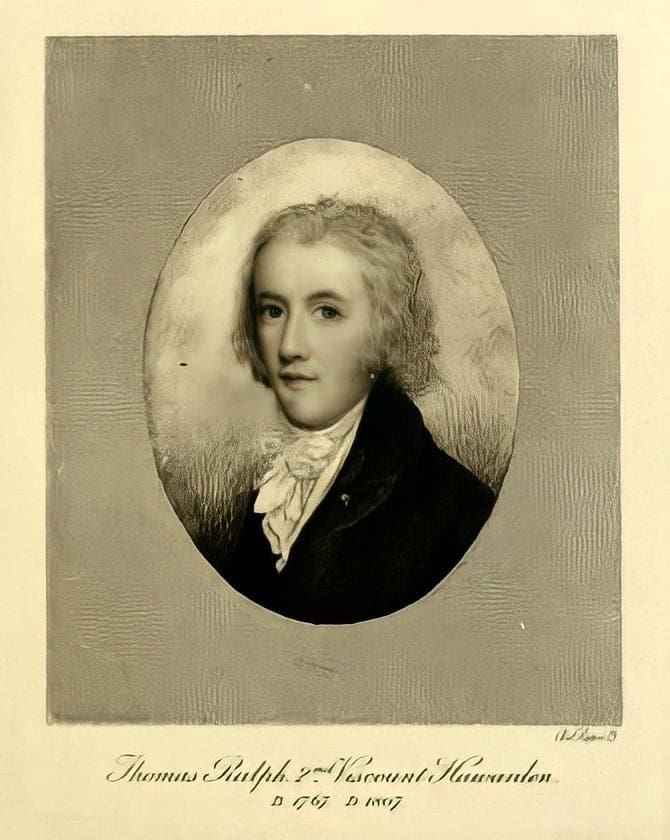
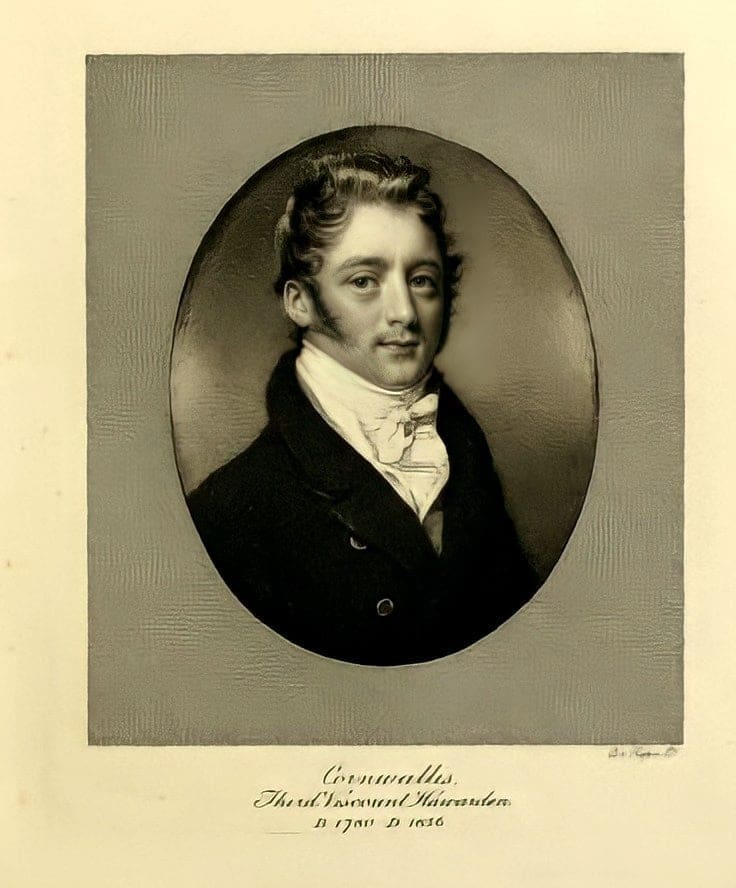
However, as we shall see, he seems to have inherited substantial financial problems from his father and letting Prior Park would certainly have been one way to alleviate those. As it happens he was to die before this was achieved and it was his half brother Cornwallis Maude, 3rd Viscount Hawarden who was to sell it to John Thomas in 1808.
William Warburton
William Warburton
William Warburton (1698 – 1779) was married to Ralph Allen’s niece and second heir, Gertrude Tucker (abt 1727 – 1796 ).
He was born at Newark on Trent. His father was a lawyer and educated him for the law, which he probably practiced 1719-23.
But he had always had a passionate liking for theology and was ordained deacon 1723 and priest 1727. He became rector at Greasley, Notts 1726, rector at Brant Broughton, 1728 and Frisby, 1730. He became chaplain to the Prince of Wales, 1735. He was a friend of Alexander Pope who left him the copyright of his works and contributed to his advancement, introducing him to William Murray, 1st Earl of Mansfield PC SL (1705 – 1793) who obtained for him the role of preacher to Lincoln’s Inn in 1746. Then he became Chaplain to the King in 1754, prebendary of Durham in 1755, dean of Bristol in 1757 and Bishop of Gloucester in 1760.
Warburton had a reputation for being excessively sarcastic and abusive though he could be charming and gracious personally.
During his 18 years at Brant Broughton, Warburton wrote The Alliance Between Church and State (1736) and The Divine Legation of Moses Demonstrated Vol 1 & The Divine Legation of Moses Demonstrated Vol 2 (1737–41). In The Alliance he advocated tolerance by the established Anglican church for those whose beliefs and worship were at variance. In The Divine Legation, he sought to demonstrate, on deist principles, the divine authority of the Mosaic writings, which deists denied. When Bishop of Gloucester he aroused opposition from Methodists for his attack on them in 1762 in The Doctrine of Grace.
The Monument
In 1765 Bishop Warburton commissioned a monument to Ralph Allen, after his death, on what is, now, known as Monument Field. It was a triangular Gothic building with a round tower on the top and a circular staircase inside.

Warburton loved Allen and had written of him
"He is, I verily believe, the greatest character in any age of the world. ... I have studied his character even maliciously, to find where the weakness lies, but have studied in vain."
The Monument demolished
The Monument was not well liked:
‘Not only was the spot ill-chosen, but the monument itself a circular tower enclosed in a triangle is devoid of all merit and interest, and nothing could be colder and balder than the inscription (composed by Bishop Hurd) placed on a slab over the door: "Memoriae sacrum Optimi viri, Randulphii Allen. Qui virtutem veram simplicemque colis, Venerare hoc saxum." (Sacred to the memory of the best man, Randolph Allen. You who worship true and simple virtue, worship this rock.)’
By the 1940s it was decaying and in need of repair. It was demolished in 1953.
Francis Thomas Fitzmaurice
In 1770 Francis Thomas Fitzmaurice, 3rd Earl of Kerry (1740-1818) obtained the lease of Prior Park from Gertrude Tucker (1727 – 1796 ), Ralph Allen’s niece and heir.
Anastasia Daly, Countess of Kerry (1720-1799) suffered poor health so Kerry’s decision to take on Prior Park was, presumably in part, owing to its proximity to the health giving Bath waters. They left Prior Park in the summer of 1772.
Francis Thomas Fitzmaurice succeeded his father, as 3rd Earl of Kerry, at the age of six in April 1747. He was placed under the guardianship of the Lord Chancellor of Ireland, as a Ward in Chancery, and was educated at Trinity College Dublin from 1755, graduating as an MA in 1759.
He was a spendthrift, but he had an enormous estate of 100,000 acres in Ireland, property in Kent and collieries in Durham.
Being left ‘a good deal to himself’, Lord Kerry fell in love with Anastasia Daly, the Roman Catholic wife and cousin) of Charles Daly of Castle Daly.
In “Trials for Adultery, Or, The History of Divorces: Being Select Trials at Doctors Commons, for Adultery, Fornication, Cruelty, Impotence, &c. from the Year 1760, to the Present Time, Including the Whole of the Evidence on Each Cause: Together with the Letters &c. that Have Been Intercepted Between the Amorous Parties, Volume 1” of 1780, Anastasia Daly, is presented as a deeply erotic figure. The book says he ‘paid her great attention’ and ‘was observed to be always near her at public places’ and describes some of their sexual encounters.
In one scene the Earl of Kerry ‘set Mrs. Daly down in a chair’ and then ‘bolted the door, and returned again to Mrs Daly, and for some time kissed and toyed with her, and then laid her down on the chairs, took up her petticoats, and had the carnal use and knowledge of her body’.
This scene is illustrated with a print, in which we see Daly sprawled across two chairs, her slender legs revealed. Notably, rather than coyly glancing away, Daly directly, confidently, looks up at her lover.
The Dalys were scandalously divorced in 1766 and on 18 March 1768 Lord Kerry and Anastasia married by special licence.
Ostracised, they left Ireland.
In 1769, heavily involved with the purchase of English properties and ‘being Indebted to Different People in Several Considerable Sums of Money’, he decided on a major land sale, which raised £58,500 14s 9½d. This is the equivalent of about £100 million today.
The Marquess of Lansdowne, his cousin and heir, wrote that “the present Lord Kerry, after being educated under the direction of the Chancellor of Ireland, and being left a good deal to himself, fell in love with a married lady twenty years older than himself, the daughter of an eminent Roman Catholic lawyer, and, obtaining a divorce, married her – an extraordinary vain woman. Having their way to fight up to get into good company, and having no posterity, they sold every acre of land which had been in our family since Henry the Second’s time.”
In “Precise and exact in the minutest things of taste and decoration: the Earl of Kerry’s patronage of Ince & Mayhew” by Hugh Roberts (2016) the changes that the Earl and Countess made to the interiors of Prior Park are described.
The Dining Room, immediately to the west of the Entrance Hall on the north side, was elegantly fitted up with twenty mahogany chairs upholstered in brass nailed green leather, a green and white painted and carved sideboard with inlaid top and mahogany wine cistern, a pair of oval gilt pier glasses and three green check festoon curtains. In the Drawing Room, next door, the six windows hung with blue silk damask drapery curtains, occupied the North West corner of the principal floor. This room was furnished luxuriously. Seating was provided by a grand suite of twelve white and gold chairs and a sofa upholstered in blue silk matching the curtains. A pair of three light giltwood girandoles carved with ribands and palm leaves hung on two of the piers, while the other two piers were filled with a pair of richly carved and gilded pier glasses above a pair of ‘very curious inlaid’ and gilded pier tables. This elegant ensemble was completed by a pair of cut-glass lustres and a fitted Wilton carpet. The Anti-Chamber, furnished and decorated in a similar way to the Drawing Room, was probably the room noted on John Wood’s 1749 ground plan as the Parlour, balancing the Dining Room, to the east of the Hall on the north side of the house. The three windows were hung with blue silk festoon curtains, the white and gold chairs and sofa upholstered with the same silk, and the window piers were each furnished with an oval carved and gilt glass above a shaped pier table with inlaid top and gilt frame. The State Bed Chamber, in the south west corner of the principal floor, had two south facing windows hung with chintz curtains and a chintz hung blue and gold domed couch bed - evidently damaged during the journey from London and requiring repair’ - six blue and gold bamboo-pattern chairs, a dressing table and a ‘French’ pier table with marble top. The adjacent Dressing Room was upholstered en-suite and had three more bamboo pattern chairs and a marble-topped marquetry ‘escrutore’ or secretaire, again probably French, which also needed repair by the partners. The Chamber Floor contained four principal bedrooms, two on the south and two larger, each with two closets, on the west side, the east end of the house being entirely occupied by a two-storey domestic chapel. Lady Kerry’s Bed Chamber, perhaps one of the two larger West facing rooms, contained a four post bed with carved and painted cornices and green striped hangings matching the window curtains, two commodes, one with a writing drawer, the other with a dressing drawer, and two mahogany clothes presses. Lord Kerry’s bedroom may have been ‘The other Pink Room’, with a four post bed with parcel gilt cornices and green mixed damask hangings matching the curtains, and an oval gilt pier glass. The majority of the North side of the Chamber Floor was taken up by the Long Gallery, stretching about 80 feet and commanding the unparalleled view over Bath from its nine windows, each hung with a green check festoon curtain, Fairly sparsely furnished, the Gallery contained fourteen green painted bamboo pattern chairs and four settees, the cushions with check cases, four carved and gilded girandoles each with two candle branches, two tea tables, two card tables and two Pembroke tables. The family pew in the Chapel opened out of the east end of the Gallery and was furnished with two red painted bamboo pattern chairs and two settees. The attic floor contained servants’ rooms, at least seven, where were to be found three of the four high quality folding beds supplied by the partners, each of which was contained within a mahogany chest ’Resembling drawers’, lined with marbled paper.“ The stone-vaulted basement was conventionally, but comprehensively, fitted out with kitchen, dairy, bake house, laundry, wine and beer cellars, servants’ hall, housekeeper's and butler's rooms.
The only contribution by Ince & Mayhew to life outside the house was the supply of a green-painted wherry or rowing boat for use on the lake, one of the last items delivered to Prior Park in October 1770.
Eighteen months after Ince & Mayhew had delivered the final packing case of furniture to Bath, the entire contents of the house and stables, the livestock and the hot-house plants were put up for sale.
There was a six days auction on the premises beginning on 20 July.
The descriptions in the catalogue, which lists forty nine rooms (or spaces) and 600 lots. Very few items reached above half their cost price, and most were well below. The total realised was £3,414 5s 6d. or around £6 million in today’s terms, which suggests that they spent the equivalent of £12 million on decorating and furnishing Prior Park for their 2 year stay!
The outgoings and expenditure incurred, including payment of £300 in rent and repairs, amounted to £4,025 6s 9d, leaving a balance owing to his agent Fenton of £621 11s 3d. This sum, adjusted upwards to £638 4s 7d, was settled by Lord Kerry with Fenton on 8 April 1773.
They spent much of the next 20 years in Paris leaving in 1792, immediately after the slaughter of the Swiss Guards and before the onset of the Reign of Terror.
Anastasia died in 1799. The inscription on her tomb, in St Andrew’s chapel in Westminster Abbey says:
“To the affectionately beloved and honoured memory of ANASTASIA COUNTESS OF KERRY, daughter of the late PETER DALY Esquire of Quansbury in the county of Galway in Ireland who departed this life on the 9th and was deposited here on the 18th day of April 1799. Her most afflicted husband FRANCIS THOMAS, EARL OF KERRY whom she rendered during 31 years the happiest of mankind, not only by an affection which was bounded only by her love for God, and to which there never was a single moments interruption, but also by the practice of the purest religion and piety, of charity and benevolence, of truth and sincerity, of the sweetest and most angelic meekness and simplicity, and of every virtue that can adorn the human mind, has placed this inscription to bear testimony of his gratitude to her, of his admiration of her innumerable virtues, and of his most tender and affectionate love for her, intending (when it shall please God to release him from his misery and call him from this world) to be deposited with her here in the same coffin, and hoping that his merciful God will consider the severe blow which it has pleased his Divine will to inflict upon him, in taking from him the dearest, the most beloved, the most charming, and the most faithful and affectionate companion that ever blessed man together with the load of his succeeding sorrows as an expiation of his past offences, and that he will grant him His grace so to live as that he may, through His divine mercy, and through the precious intercession of our blessed Lord and Saviour Jesus Christ, hope for the blessing of being soon united with her in eternal happiness.”
If the inscription on the Kerry tomb in Westminster Abbey is to be believed, following the death of his wife he devoted the rest of his life to piety and good works, endeavouring “to atone for a long life of thoughtlessness”. Little remained of his vast estate.
Horace Walpole said of Kerry that he was a ‘simple young Irish peer, who had married an elderly Irish woman that had been divorced on his account and had wasted a vast estate in the idlest ostentation’
Edward Candler Brown
Edward Candler Brown
As stated above, in the period 1805 to 1807 Edward Candler Brown (1732 – 1807) was residing at Prior Park. Apparently through his mother, Mary Ryves Candler, Edward Candler inherited substantial properties from Margaret Cecil Brown, widow of Sir Robert Brown and daughter of Robert Cecil, second son of James Cecil, 3rd Earl of Salisbury.
Under Royal license, Edward Candler took the name Candler Brown in 1803.
A Genealogical and Heraldic History of the Landed Gentry of Great Britain & Ireland, Volume 1 by Sir Bernard Burke has him living at Prior Park and Bath directories for 1805 and 1806 list him as there too. He also lived at Combe Hill House, before living at Prior Park, and owned Tucking Mill, which he sold to William ‘Strata’ Smith.
John Thomas
John Thomas
As the Maudes had never really lived at Prior Park, and he had no real family attachment to it, it seems reasonable to assume that there may have been little real attachment to it from Cornwallis Maude, 3rd Viscount Hawarden. In 1808, when he became 3rd Viscount, Prior Park was sold to John Thomas (1752 – 1827), a Quaker, whose, according to a Thomas family website about him:
“chief interest …… was the promotion of waterways for the facilitation of trade, especially the Somerset Coal Canal, and the proposed Kennet and Avon Canal to connect Bath with London. John Thomas the second retired in 1812 and purchased Prior Park, near Bath, where he died 3rd March 1827, aged seventy-five".[5]
The price appears to have been £28,000 payable in 2 instalments of £10,000 and £18,000 within 2 years.
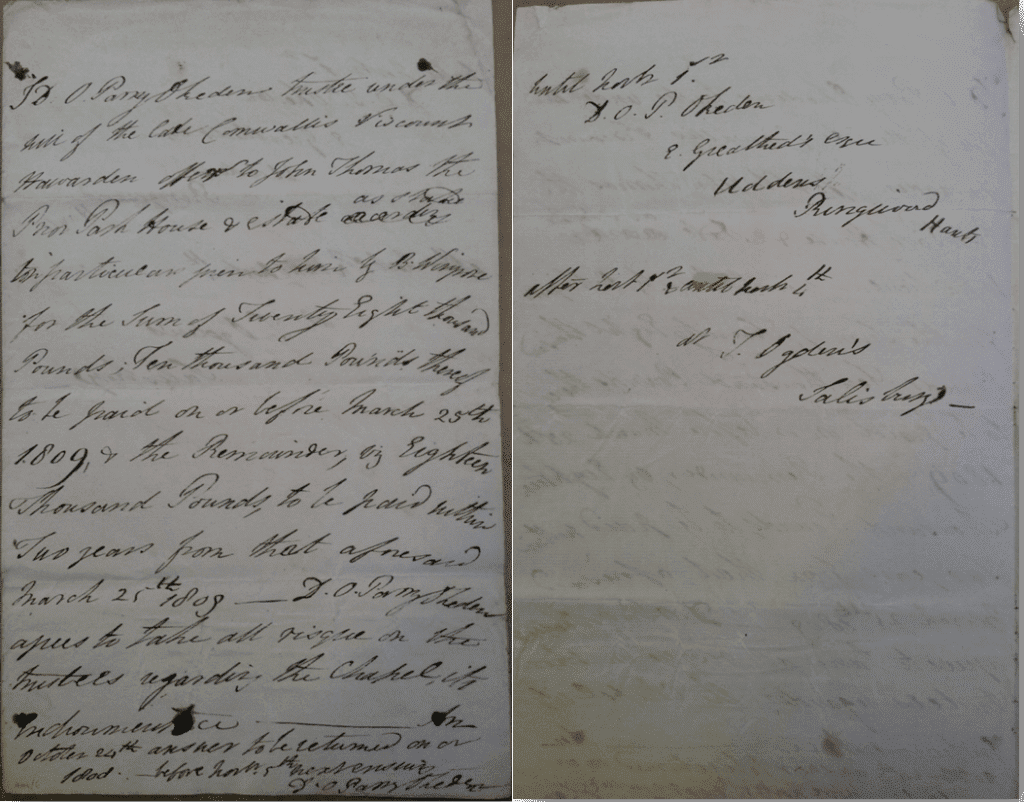
It is said that John Thomas (abt 1752 – 1827) recouped the sale price by cutting down for timber many of the nearly 60,000 trees that Ralph Allen had planted, and it is certain that there was a sale of over 1,300 trees in 1810. To recoup the cost of Prior Park he would have had to have got an average of about £23 per tree. The person to apply to for more particulars about the sale was one Benjamin Wingrove.
It does not seem unreasonable then that he may, effectively, have bought the estate for nothing! Oak, elm, beech, ash and fir were all used in the building of warships at the time as well as in house building. The country was at war, Napoleon was trying to blockade the Baltic, imported timber was difficult to come by and the price of timber had risen. A tax had been placed on Baltic timber in 1808, and had been doubled in 1810 to allow Canadian timber to compete and to ensure the country was not reliant on the Baltic countries. Since 1802 the price of fir had risen 300%[6].
John Thomas’ grandfather was another John Thomas (1690 – 1760) of Welshpool and Bristol, who was an inventor and ironmaster. He was co-inventor with Abram Darby of casting cooking pots in iron. His father Samuel Thomas (d.1801) had been a wire drawer in Keynsham.
John Thomas (abt 1752 – 1827) himself established a wholesale grocery business in Redcliff Street, John Thomas & Sons, but was also a self-taught engineer. He became superintendent of works for the building of the Kennet & Avon canal for the building of which £881,368 16s 3d[7] had been raised in 1794. The canal is 57 miles long with 79 locks; 31 locks rising to a summit level 474’ above sea level at Savernake and 48 locks falling to Bath. The Bruce Tunnel under Savernake is 502 yards long. It was completed and opened on 28th December 1810 and flourished for the next 60 years until the railways took over almost completely in the 1870s though commercial navigation went on until about 1920.
There is a plaque to John Thomas on the North face of the Dundas Aqueduct:
TO THE MEMORY OF JOHN THOMAS, BY WHOSE SKILL, PERSEVERANCE AND INTEGRITY, THE KENNET AND AVON CANAL WAS BROUGHT TO A PROSPEROUS COMPLETION, A.D. M.DCCC.X. THE PROPRIETORS GRATEFULLY INSCRIBE THIS TABLET. A.D. M.DCCC.XXVIII
John Thomas died in 1827 and his executors sold much of the Prior Park estate on 10 July 1828. The rest was sold by the executors of his son, John Ovens Thomas (1778 – 1836), in 1846.
His obituary, published in The Gentleman Magazine[8] said:
Mr. John Thomas. March 8. At Prior Park, near Bath, which he purchased about fifteen years since, aged 74, Mr. John Thomas, one of the Society of Friends. He commenced business as a grocer in Bristol, and afterwards established a wholesale house in the same line in partnership with his sons. Being endowed with eminent talents for Mechanics and Engineering, which were called into action in 1793 when the public mind was excited to speculation in Canals, be took a great interest in that projected to unite the cities of London and Bristol by connecting the rivers Kennet and Avon, and was one of the earliest members of the Committee of Management. The expenditure having, as might be expected from a concern of such magnitude, exceeded the original estimate, this great work languished in its execution. At the express desire of the Managing Committee, Mr. Thomas undertook the superintendence of it at a salary of £750 for all his time, labour, and expences. The amount of the salary is here mentioned, because it has been idly believed that part of his large for tune was accumulated in the management of that concern. His unimpeachable integrity obtained and secured the confidence of the various interests with which be bad to contend, and his strong practical sense and unwearied attention directed the execution, and effected the completion, of this perhaps the best constructed Canal in Europe. After be had resigned the superintendence, he gave his disinterested attention to the conduct and management of the affairs of the Company to almost the last moment of his life. But in the midst of active pursuits of this and other kinds, the preparation for another state of existence was not for gotten. So long as the Great Bestower of health was graciously pleased to grant to him the possession of it, so long were his useful talents exerted in the promotion of public charities, and a large portion of his ample means employed in acts of private benevolence. His opinions and advice were generally sought for; and his attendance on public business, at a period of life when other men retire from it, was useful in a religious and moral view; for it is pleasing and instructive to see strong abilities preserved by temperence and exercise to advanced age, and employed with disinterestedness. His morals were pure and exemplary, and his religion practical, regular, and unobtrusive. He mixed in general society more than is common for those of his persuasion, and brought into it the most urbane and simple manners, never abstaining from the participation of cheerful and enlivening conversation. He was patient in hearing, and slow in reply: and although this might be partly owing to the early discipline of his society, yet the clearness of expression and soundness of argument which marked his observations were peculiarly his own. He was indulgent to the religious opinions of others, and without relinquishing the general views and habits of Friends, he felt far from a bigoted attachment to them. He possessed the adventitious ornaments of a fine expressive countenance, a well-proportioned and rather athletic form, and a general appearance which almost always made a favourable impression. This excellent man was the father of a numerous family, all of whom stood around his death bed, attentive to his latest comforts, and partaking his dying advice and benediction. To them it must afford a melancholy pleasure to be assured that their sorrows are shared in various degrees by many friends and acquaintances, and that feelings of regret for his loss extend to every one to whom their departed friend's name was known, and by whom his character could be properly estimated.
Bishop Baines
Bishop Baines

Peter Augustine Baines (1786 – 1843) was professed at Ampleforth in June 1804 when he was 18. He made rapid advances through various monastic offices which resulted in his appointment to the mission of Bath.
Catholic Emancipation did not occur until Roman Catholic Relief Act 1829, but the population of Bath included a large Catholic element and Baines’ eloquence along with with “an excellent organ and a fine choir” gave rise to a stream of converts and the re-emergence of large numbers of “buried” Catholics.
In 1823 Peter Collingridge, the Vicar Apostolic of the Western District petitioned Rome for Baines as his coadjutor and he was raised to the purple as Bishop of Siga in partibus infidelium.
However Baines was quite high handed and had a number of disagreements such as ordering the income from the Bath mission to be paid over to him and not its Benedictine owners. The Benedictines refused and threatened to close the chapel and sell the property. Baines withdrew but and set up his own chapel. He then suggested that Downside monastery and lands should be made over to him and his successors as a training college for priests. Downside ignored him and his health broke down.
A prolonged rest in Rome worked wonders and Baines was soon preaching at Cardinal Wiseman‘s request at the English Church in the Corso. Wiseman said that “the great power of Baines lay in his delivery, voice, tone, look and gesture. His whole manner was full of pathos and there was a tremulousness of voice which gave his words more than double effect”.
He began to plan further moves in his battle with the monks of Downside by gaining the ear of Leo XII and stating his hopes for the Western District to be frustrated by the lack of a seminary, adding that the Downside Foundation was uncanonical, the vows of the monks invalid and their property rightfully his own. Downside found a Papal document authorizing the foundation and a deputation sent it to Rome with a letter of protest signed by the whole community.
Leo XII had died and Pius VIII recommended a compromise but Baines refused,
He said “If it comes to a trial of strength one or other party shall go down”. He then called on the monks to show, within four days, why they considered themselves exempt from his jurisdiction. They replied, temperately, that the matter was still sub judice. He placed the Abbey under an Interdict and withdrew the monks faculties to hear confessions and administer the sacraments. This time he had overplayed his hand. The Pope ordered immediate restoration of the faculties and issued a sanatio to purge any irregularities there have been in the canonical erection of the monastery. Baines, conceding defeat, went to Downside and humbly begged pardon of the whole community.
Baines now embarked on a more ambitious scheme. With £1,000 in cash and a £22,000 mortgage Prior Park was bought by Bishop Baines in 1829. His objective was to found a college for the education of Catholic boys of good family, and a seminary for the training of Priests.
Three monks from Ampleforth formed the teaching staff and 26 students with their books and possessions decided to join them. Much bitterness and controversy was caused by this “migration” and the bishop himself asked Gregory XVI for a Court of Arbitration. After lengthy deliberations the Court found enticement was not proved, but concern was expressed at the bishop’s handling of financial matters.
All of Bishop Collingridge’s savings of £6,000 had been sunk in a “bottomless abyss” together with all the mission funds and various legacies. Even the servants received only part of their wages, the balance being “invested” in the college on their behalf.
He built two colleges at either end of the mansion house. He heightened and enlarged the East wing as a lay college which he dedicated to St. Peter. He turned the West wing into a seminary dedicated to St. Paul.
He employed a number of designers, including John Peniston & Son of Salisbury (East wing, 1831), H.E. Goodridge (West wing, 1834) and J.J. Scoles (church of St. Paul, 1844 – 1882).[9] He commissioned Goodridge to add the Baroque flight of steps to the North front of the mansion in 1836.


The house was gutted by a serious fire in the same year which is described in the Bath Chronicle and Weekly Gazette on Thursday 2nd June 1836 which says the damage was £12,000 to £15,000 but that the insurance with Norwich Union was only £6,000.
With the proceeds of a public appeal Baines set about the work of restoration.
Bishop Baines really believed that a Roman Catholic theological college was needed. He believed that as the Catholic Church emerged from years of persecution it needed educated priests and an educated laity. It was an ambitious scheme, including a school, a seminary and university:
“While still a coadjutor he sought to make the District a Benedictine see, with Downside its diocesan seminary. Distrust of the Bishop and disinclination to identify the community with a particular diocese made the monks unanimously reject his proposal…He purchased Prior Park, a Georgian mansion and a fine specimen of Palladian architecture…The foundation would combine a boys’ school, college, and seminary. He intended it to grow into a University.”[10]
Unfortunately the scheme was never a success. It seems the buildings were too vast for the number of students and the clergy feared it would absorb all their resources.
In March of 1842 he suffered a stroke which paralysed his left side and doctors forbade him to transact business of any kind. Baines died in 1843.
With all his faults, the bishop had stirred public imagination and it is recorded that at the interment “hardly an eye was dry”.
His clerical brethren however, were not so well disposed, particularly when his affairs revealed a state of hopeless insolvency which continued till 1850 when in a final debacle everything was sold to appease the creditors.
Alexander Raphael
In January 1850 Prior Park was bought by Alexander Raphael M.P. for £30,000 and he rented it back to the college on a 200 year lease at 3% interest p.a.
Alexander Raphael (1775-1850) was born in Madras, his father was said to be an Armenian Jew, his mother a Roman Catholic and he became a Roman Catholic.
He was a wealthy stockbroker, served on Kingston on Thames Corporation and as High Sheriff of London in 1834 where he lost the tip of his left index finger in a fight with a criminal. He was responsible for the development of Surbiton as a new town.
He was returned as a Liberal MP from the Irish constituency of County Carlow, at a by-election in June 1835. However the election was challenged on petition and he was unseated on 19 August 1835. Raphael succeeded in entering the House of Commons as a Catholic Tory from St Albans in 1847 and retained the seat until his death in November 1850.
Alexander Raphael was a philanthropist and is said to have given the Roman Catholic Church £100,000 in the years before his death. It seems that he intended to give Prior Park to the church too but as the Cardinal was loathe for his name to be in the will things slowed down and he died before a solution was reached.
Thus Prior Park passed to his nephew Edward Raphael (1814-1888) a Q.C and brother in law of the Earl of Mexborough, though it was still occupied by the college. However by 1856 the debts had become too much, the interest could not be paid and Edward Raphael took possession of the Prior Park Estate.
The college was closed in 1856 and a sale of its contents ensued. Edward Raphael also tried to sell the estate, but failed. The estate was re-purchased by Bishop William Hugh Joseph Clifford (24 Dec 1823 – 14 Aug 1893), Bishop of Clifton for £23,000 in 1867 and the staff and pupils from The Bristol Catholic Grammar School came to Bath.
Thomas Thompson
Thomas Thompson (1785–1865) made a fortune on the London Stock Exchange, and retired while still a young man becoming a philanthropist.
He was an early prominent member of the London Missionary Society, the British and Foreign Bible Society, and one of the founders in 1818 of the British and Foreign Sailors Society (originally the Port of London Society).
His first wife was Elizabeth Pinckney (1790-1837) and one of their 8 children was Jemima (1813-1906) a writer of hymns, religious studies and biographies during the Victorian era. She is best known for her children’s hymn “I think when I read that sweet story of old”. After his death Jemima wrote a book about her father: Sketches of the life and character of Thomas Thompson, by his daughter, Jemima Luke, Jan 1868
His second wife (and her second husband) was Charlotte Margaret Noel (1792-1869), who was the sister of Charles Noel Noel, 1st Earl of Gainsborough (1781-1866).
He and Charlotte came to Prior in 1856, taking a lease from Edward Raphael. Thompson died at Prior Park in 1865 and Charlotte also, but 4 years later in 1869.
Prior Park Industrial School
Prior Park Industrial School
In 1917, Cannington Industrial School for Roman Catholic Boys relocated to Prior Park becoming Prior Park Industrial School. In January 1917, it was certified for the accommodation of up to 150 boys, aged from 9 to 10 years at their date of admission. George L. Harding, continued as superintendent.
Industrial schools, set up under the Industrial Schools Act 1857, had two main objects, to instil in the children the habit of working and to develop the latent potential of the destitute child. They were intended to help children who were destitute but who had not committed any serious crime. The idea was to remove the child from their home environment, free them from bad influences, give them an education and teach them a trade.
The timetable was quite a strict one, the children rose at 6.00am and went to bed at 7.00pm. During the day there were set times for schooling, learning trades, housework, religion in the form of family worship, meal times and there was also a short time for play three times a day. The boys learned trades such as gardening, tailoring and shoemaking; the girls learned knitting, sewing, housework and washing.
Parents were supposed to contribute to the cost of keeping a child in an Industrial School. This often proved impossible because most of the children were homeless. As time went on there was quite a lot of unease about the funding mainly because of the rapid expansion of the system. Some people thought it was too big a drain on the public purse as magistrates preferred to send young offenders to the schools instead of prison. From 1870 the schools became the responsibility of the Committee of Education.
The chained boy case

In August 1919, 13 year old Frederick Green, was found by a policeman at 3 a.m. limping along a Bath street with a dog chain attached to his right foot.
He said he had been chained up at the school and beaten on the head with a rolling pin. He escaped through a window only 14 inches by 11 inches and then slid down a drainpipe.
The superintendent, George L. Harding, said Green was incorrigible and had made many attempts to escape.
In court Green testified that he had arrived at Prior Park from the Ilford Industrial School on July 24, and, alleging that he had tried to escape, the superintendent, punched him on the jaw and had his head shaved.
The following day he ran away, but was captured at Hungerford, and Henry White, the School’s manual instructor, had put chains on his ankles.
The next morning, one of the boys chained him to a table in the kitchen, and Mr Harding struck him several times with a rolling-pin. Green had said “Sorry, sir,” and Harding had struck him again.
Green said that he had remained in chains for the next two days, and in the evening they were taken off and his cut ankles dressed with iodine.
When Green told Harding that he wished to go to sea, Harding had hit him on head, ribs, and leg, and, being chained to the table, Green could not dodge him.
Other boys testified as to seeing Green in chains, and a boy called Philpott stated that Harding had struck Green several times with his fist.
Gaston Renard, gardener, Charles Rosenthal, master tailor, and Henry White, manual instructor, were also stated by Green to have ill treated him.


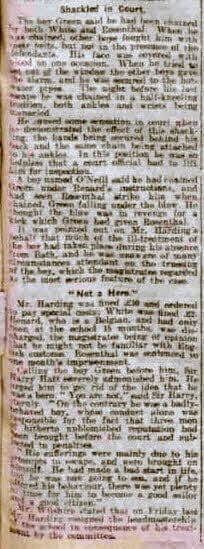
Dr J. M. Harper, a police surgeon, said there were three very recent scars on Green’s head. He had a cut lip, contusions over the shoulders, ribs, back, left thigh, chest and arms, and there were deep lacerated sores over the wrists and left instep. There were also marks on the head caused by a blunt instrument.
Harding, Rosenthal, White & Renard denied ill treatment. Harding was found guilty and fined £10 plus costs. Renard was found not guilty, White was fined £2, and Rosenthal, whose conduct was described by the bench as extremely cruel, was sentenced to a month’s imprisonment.
The magistrates strongly criticised the Management Committee for neglect and a change of management was inevitable. In 1920, the running of the School was taken over by the Christian Brothers. Rev. Brother G.S. Roche was appointed superintendent.
A report on the School in 1920 noted that the boys each had three outfits: a tweed suit, a blue serge suit, and corduroy knickerbockers with a tweed jacket. The also wore monogrammed cricket caps and had clean starched collars, thanks to the large steam laundry on the premises. Most of the boys went home at holiday times, with three weeks being allowed in the summer. The boys played football matches with other sides in the area including the Nautical School at Portishead and the Bath Ladies Football Club.
Prior Park resigned its Industrial School certificate in April 1924.
Summary since 1895
Summary of developments at Prior Park from 1895
1895 The College was taken over by the Christian Brothers on a 7 year lease
1902 Christian Brothers left Prior Park College, school was run by the Clifton Diocese
1904 Prior Park College closed at the end of the Lent term
1914 The College buildings were requisitioned by the War Office
1917 The Home Office established the Cannington Industrial Reform School
1921 The Christian Brothers returned, purchasing Prior Park from the Diocesan authorities
1924 Boarding pupils and staff transferred from St Brendan’s College, Bristol
1940 The new school block was completed and requisitioned by the Admiralty
1942 St Paul’s was badly damaged by bombs
1959 Science School built, grant from Ind. Fund for Advancement of Science Teaching
1965 New 6th form block linking Science School and School Block was completed
1965 The Priory was purchased for eventual school use
1966 Restoration of Mansion steps and balustrade was completed
1973 All weather hockey pitch completed
1974 Burke Memorial Pavilion completed
1981 Christian brothers left the College and lay administration took over the administration
1983 Girls joined the College
1991 16th August, fire gutted interior of the mansion
1993 Julian Slade Theatre opens
1995 Mansion reopens after major rebuild completed
2007 Mackintosh Dance Studio opens
2009 The addition of Baines House (11-13yr olds)
2014 The Creative Design Centre opens in St Peter’s
2015 Bury Sports Centre opens
Bathampton and Claverton Manors
What happened to Bathampton Manor and Claverton Manor?
Ralph Allen had also owned Bathampton Manor and Claverton Manor. He left Bathampton and Claverton Manor to his brother Philip Allen:
“…..all that my Manor, with all lands and hereditaments thereto belonging, situate and being in the parish of Bathampton aforesaid, with all Courts, Royalties, Jurisdictions, and Rights whatsoever thereto appertaining (except the Warren), and also all that my Estate and interest of and in the Lands and Estate I purchased of His Grace the Duke of Kingston, and now out upon the lives of William Skrine, Esq. and his sister, To the use of my brother Philip and his heirs for ever in lieu of the £200 per annum I am obliged to pay him by his said Marriage articles.”

Claverton Manor
Ralph Allen’s will made it clear that his nephew Capt. William Tucker R.N. was to be a major heir and I assume that the family agreed that his son Allen Tucker (1769 – 1816) should have possession[11]. After his death it passed out of Allen family possession as his executors sold Claverton to John Vivian (1756 – 1828). who built the new house that we see now as The American Museum, the previous one was built c.1625.
After his death Claverton Manor passed to his son George Vivian (1798-1873) who sold it to Isaac Carr in 1869. This was the Isaac Carr of Isaac Carr & Co woollen mills at Twerton.
Isaac Carr sold it to Henry Duncan Skrine (1815 – 1901) in 1874. George Vivian’s daughter Minna Frances Vivian (1848 – 1907) then married Rev Vivian Eccles Skrine (1850 – 1925) who was Henry Duncan Skrine’s son. However, Claverton Manor passed to Henry Duncan Skrine’s oldest son Col Henry Mills Skrine (1844 – 1915) and then to his eldest daughter Anna Dorothea Mary Skrine (1874 – 1956).
During the Second World War the manor became the headquarters of the Royal Air Force No. 32 (Balloon Barrage) Group. Stationed here was Squadron Leader Kenneth Horne (1907 – 1969) who recorded the wartime radio programme ‘Ack-Ack, Beer Beer’ (service jargon for Anti-Aircraft Balloon Barrage). He later went on to do popular radio shows such as ‘Much Binding in the Marsh’ and ‘Round the Horne’.
Following Anna Dorothea Mary Skrine’s death, Claverton Manor and estate and parts of the Warleigh estate were sold in 1957 to Broadlands Properties Ltd., in order to meet death duties and help towards the maintenance of Warleigh Manor. The contents of Warleigh Manor were sold in May 1957. Claverton Manor was let to the Bath Corporation and used as a hostel for students at the Training College of Domestic Science[12].
In 1958 it was bought by John Judkyn (1913 – 1963) and Dr Dallas Pratt (1914 – 1994) the co-founders of the American Museum in Britain and became the American Museum.
Bathampton Manor
Bathampton Manor remained in the Allen family for many years. Ralph Allen’s brother Philip also had a son called Philip and he passed it to his heir Henry Edmund Allen, who died in Geneva in 1829, being succeeded by his son Ralph Shuttleworth Allen who married firstly into the Cunard family, Anne Elizabeth Cunard, and then another Allen – Augusta Etheldreda.
Ralph Shuttleworth Allen was succeeded by his eldest son, Major General Ralph Edward Allen C.B. J.P. When he died it passed to his brother Henry Allen who sold it as the Allen family had not lived at Bathampton Manor for some time.
It became the residence of Charles Price Davis J.P. and his wife. Charles Price Davis died in 1927 and Mrs. Price Davis in 1938.
It was then owned by Colonel Sir Claude Dansey, a spy with MI6 with a somewhat controversial reputation, who died in the Lansdown Grove Hospital, Bath, on 11th June 1947.
Lady Frances Gurney Dansey, his widow, sold it later in 1947 for £6,075 to be a ‘home for genteel ladies in need’. It is still run as a care home for the elderly by BCVS which evolved from the 1947 purchase.

